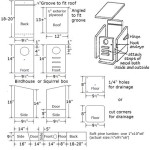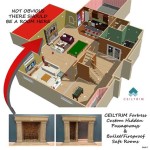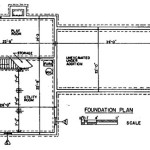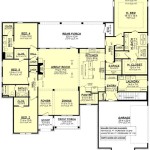A house plan is a set of detailed drawings that provide instructions for the construction of a house. These plans typically include floor plans, elevations, and sections, which show the layout of the house, the exterior appearance, and the interior structure. House plans are essential for obtaining building permits, estimating construction costs, and coordinating the work of contractors.
Drawing a house plan requires careful planning and attention to detail. The first step is to determine the overall size and shape of the house. Next, the floor plan should be drawn, which shows the arrangement of the rooms and the flow of traffic. Elevations and sections can then be drawn to show the exterior and interior details of the house.
In the following sections, we will provide a step-by-step guide on how to draw a house plan. We will cover the basic principles of house design, as well as the specific techniques used to draw floor plans, elevations, and sections.
Here are 10 important points about how to draw a house plan:
- Determine the overall size and shape of the house.
- Draw the floor plan, which shows the arrangement of the rooms and the flow of traffic.
- Draw elevations and sections to show the exterior and interior details of the house.
- Use a scale to ensure that the drawings are accurate.
- Include all necessary dimensions and details.
- Label all rooms and spaces.
- Use different line weights to distinguish between different elements of the drawings.
- Create a title block that includes the project name, date, and scale.
- Have the plans reviewed by a professional before submitting them for building permits.
- Follow all local building codes and regulations.
By following these steps, you can create a house plan that is clear, accurate, and complete.
Determine the overall size and shape of the house.
The first step in drawing a house plan is to determine the overall size and shape of the house. This will be determined by a number of factors, including the number of bedrooms and bathrooms, the desired square footage, and the lot size. It is important to consider the size and shape of the house in relation to the lot size, as well as the surrounding houses.
Once you have determined the overall size and shape of the house, you can begin to draw the floor plan. The floor plan should show the arrangement of the rooms and the flow of traffic. It is important to consider the function of each room and how it relates to the other rooms in the house.
The shape of the house will also affect the exterior appearance of the house. For example, a house with a simple rectangular shape will have a more traditional appearance, while a house with a more complex shape will have a more modern appearance.
It is important to take your time when determining the overall size and shape of the house. This is a critical step in the design process, and it will affect all of the other decisions that you make.
Here are some tips for determining the overall size and shape of the house:
- Consider the number of bedrooms and bathrooms that you need.
- Think about the desired square footage of the house.
- Consider the size and shape of the lot.
- Look at the surrounding houses to get an idea of the typical house size and shape in the neighborhood.
- Draw a rough sketch of the house to get a general idea of the size and shape.
Once you have determined the overall size and shape of the house, you can begin to draw the floor plan.
Draw the floor plan, which shows the arrangement of the rooms and the flow of traffic.
The floor plan is one of the most important parts of the house plan. It shows the arrangement of the rooms and the flow of traffic. It is important to consider the function of each room and how it relates to the other rooms in the house.
When drawing the floor plan, it is important to use a scale to ensure that the drawings are accurate. The scale will also help you to determine the size of the rooms and the overall size of the house.
Here are some tips for drawing the floor plan:
- Start by drawing the exterior walls of the house. This will give you a basic outline of the house and help you to determine the size and shape of the rooms.
It is important to label the exterior walls with the dimensions, such as length and width.
- Next, draw the interior walls of the house. The interior walls will divide the house into different rooms.
Be sure to label the interior walls with the dimensions, such as length and width.
- Once you have drawn the walls, you can begin to add the rooms. The rooms should be labeled with their names, such as living room, kitchen, bedroom, and bathroom.
It is important to consider the function of each room and how it relates to the other rooms in the house.
- Finally, add the doors and windows to the floor plan. The doors and windows should be labeled with their dimensions, such as height and width.
It is important to consider the flow of traffic when placing the doors and windows.
Once you have completed the floor plan, you can begin to draw the elevations and sections.
Draw elevations and sections to show the exterior and interior details of the house.
Elevations and sections are drawings that show the exterior and interior details of the house. Elevations are two-dimensional drawings that show the exterior walls of the house, while sections are two-dimensional drawings that show the interior structure of the house.
Elevations are used to show the overall appearance of the house, as well as the relationship between the different parts of the house. Sections are used to show the interior details of the house, such as the layout of the rooms, the placement of the windows and doors, and the height of the ceilings.
Both elevations and sections are important for communicating the design of the house to builders and other contractors. They can also be used to obtain building permits and to estimate the cost of construction.
To draw elevations and sections, you will need to use a scale to ensure that the drawings are accurate. You will also need to use different line weights to distinguish between different elements of the drawings.
Here are some tips for drawing elevations and sections:
For elevations:
- Start by drawing the exterior walls of the house. This will give you a basic outline of the house and help you to determine the size and shape of the house.
- Next, add the windows and doors to the elevation. The windows and doors should be labeled with their dimensions, such as height and width.
- Finally, add any other details to the elevation, such as siding, roofing, and trim.
For sections:
- Start by drawing the floor plan of the house. This will give you a basic outline of the house and help you to determine the location of the different rooms.
- Next, draw the walls of the house. The walls should be labeled with their dimensions, such as height and width.
- Finally, add any other details to the section, such as windows, doors, and fixtures.
Once you have completed the elevations and sections, you will have a complete set of drawings that show the exterior and interior details of the house.
Use a scale to ensure that the drawings are accurate.
Using a scale is essential for ensuring that your house plans are accurate. A scale is a ratio that compares the size of the drawing to the size of the actual house. For example, a scale of 1/4 inch = 1 foot means that 1 inch on the drawing represents 4 feet in the actual house.
- Using a scale will help you to:
Determine the overall size and shape of the house. A scale will help you to determine the overall size and shape of the house by providing a consistent way to measure the dimensions of the house.
- Draw the floor plan. A scale will help you to draw the floor plan by providing a consistent way to measure the dimensions of the rooms and the placement of the walls.
- Draw elevations and sections. A scale will help you to draw elevations and sections by providing a consistent way to measure the height and width of the walls, windows, and doors.
- Communicate the design of the house to builders and other contractors. A scale will help you to communicate the design of the house to builders and other contractors by providing them with a clear and accurate representation of the house.
When choosing a scale, it is important to consider the size of the house and the level of detail that you need. For small houses, a scale of 1/4 inch = 1 foot may be sufficient. For larger houses, a scale of 1/8 inch = 1 foot or 1/16 inch = 1 foot may be more appropriate.
Once you have chosen a scale, be sure to use it consistently throughout all of your drawings. This will ensure that your drawings are accurate and easy to understand.
Include all necessary dimensions and details.
In addition to using a scale, it is also important to include all necessary dimensions and details on your house plans. This information will help builders and other contractors to understand the design of the house and to construct it accurately.
- Dimensions: All of the dimensions on your house plans should be clearly labeled. This includes the length and width of the house, the height of the walls, and the size of the windows and doors.
It is also important to include the dimensions of any other features of the house, such as porches, decks, and garages.
- Details: In addition to dimensions, you should also include all necessary details on your house plans. This includes information about the type of materials that will be used for the construction of the house, the type of foundation that will be used, and the type of roof that will be installed.
You should also include details about any special features of the house, such as fireplaces, built-in cabinets, or solar panels.
- Notes: You can also use notes to provide additional information about the house plans. For example, you can use notes to explain the function of a particular room or to specify the type of materials that should be used for a particular feature.
Notes can also be used to provide instructions for the builders or other contractors.
- Symbols: Symbols can be used to represent different elements of the house on the plans. For example, a circle may be used to represent a light fixture, and a square may be used to represent a window.
Symbols can help to make the plans more concise and easier to understand.
By including all necessary dimensions and details on your house plans, you will help to ensure that the house is built according to your specifications.
Label all rooms and spaces.
Labeling all rooms and spaces on your house plans is an important step in the design process. It helps to identify the function of each room and to make it easier for builders and other contractors to understand the design of the house.
To label a room or space, simply write the name of the room or space in the center of the room or space. For example, you would write “Living Room” in the center of the living room.
If a room or space has a specific function, you can also include a brief description of the function in the label. For example, you could label a room “Guest Bedroom” or “Home Office”.
In addition to labeling rooms and spaces, you can also label other features of the house, such as closets, pantries, and bathrooms. This will help to make the plans more clear and easier to understand.
Here are some tips for labeling rooms and spaces on your house plans:
- Use clear and concise labels. The labels should be easy to read and understand.
For example, instead of labeling a room “BR”, label it “Bedroom”.
- Use consistent labels. Use the same label for the same room or space throughout the plans.
For example, don’t label a room “Living Room” on one sheet of the plans and “Great Room” on another sheet of the plans.
- Label all rooms and spaces. Don’t forget to label even the smallest rooms and spaces.
This will help to make the plans more complete and easier to understand.
By labeling all rooms and spaces on your house plans, you will help to ensure that the house is built according to your specifications.
In addition to labeling rooms and spaces, you can also label other features of the house on the plans. This includes features such as:
- Closets
- Pantries
- Bathrooms
- Fireplaces
- Built-in cabinets
- Solar panels
Labeling these features will help to make the plans more clear and easier to understand.
You can also use symbols to represent different elements of the house on the plans. For example, a circle may be used to represent a light fixture, and a square may be used to represent a window.
Symbols can help to make the plans more concise and easier to understand.
By labeling all rooms and spaces on your house plans, you will help to ensure that the house is built according to your specifications. You will also make it easier for builders and other contractors to understand the design of the house.
Here is an example of a well-labeled house plan:
[Image of a well-labeled house plan]
As you can see, all of the rooms and spaces are clearly labeled. This makes it easy to understand the design of the house and to see how the different rooms and spaces relate to each other.
Use different line weights to distinguish between different elements of the drawings.
Using different line weights is an important way to distinguish between different elements of the drawings. This will help to make the plans more clear and easier to understand.
- Use a heavier line weight for the exterior walls of the house. This will help to differentiate the exterior walls from the interior walls.
For example, you could use a line weight of 0.5 mm for the exterior walls and a line weight of 0.3 mm for the interior walls.
- Use a lighter line weight for the interior walls of the house. This will help to create a sense of depth and space in the plans.
For example, you could use a line weight of 0.3 mm for the interior walls.
- Use a different line weight for different types of doors and windows. For example, you could use a heavier line weight for exterior doors and windows and a lighter line weight for interior doors and windows.
This will help to make it easy to identify the different types of doors and windows on the plans.
- Use a different line weight for different types of materials. For example, you could use a heavier line weight for concrete walls and a lighter line weight for wood walls.
This will help to make it easy to identify the different types of materials that will be used in the construction of the house.
By using different line weights to distinguish between different elements of the drawings, you will help to make the plans more clear and easier to understand.
Create a title block that includes the project name, date, and scale.
The title block is an important part of the house plans. It provides basic information about the project, such as the project name, date, and scale. This information is essential for builders and other contractors to understand the design of the house and to construct it accurately.
- Project name: The project name should be clear and concise. It should accurately reflect the name of the project.
For example, if the project is to build a new house, the project name could be “New House Construction”.
- Date: The date should be the date on which the plans were created. This date is important for tracking the progress of the project and for ensuring that the plans are up to date.
For example, the date could be “January 1, 2023”.
- Scale: The scale should be the same scale that was used to create the drawings. This information is essential for builders and other contractors to understand the size of the house and to construct it accurately.
For example, the scale could be “1/4 inch = 1 foot”.
- Sheet number: If the plans are divided into multiple sheets, each sheet should have a unique sheet number.
For example, the sheet number could be “Sheet 1 of 5”.
The title block should be placed in the lower right-hand corner of the sheet. It should be clearly visible and easy to read.
Here is an example of a well-designed title block:
[Image of a well-designed title block]
As you can see, the title block includes all of the necessary information, and it is clearly visible and easy to read.
Have the plans reviewed by a professional before submitting them for building permits.
Once you have completed the house plans, it is important to have them reviewed by a professional before submitting them for building permits. A professional can review the plans for accuracy and completeness, and can also provide valuable feedback on the design of the house.
There are many different types of professionals who can review house plans. Some of the most common include:
- Architects: Architects are licensed professionals who are trained to design buildings. They can review your house plans for accuracy and completeness, and can also provide valuable feedback on the design of the house.
- Engineers: Engineers are licensed professionals who are trained to design and build structures. They can review your house plans for structural soundness and safety.
- Building inspectors: Building inspectors are responsible for enforcing building codes. They can review your house plans to ensure that they comply with all applicable building codes.
The cost of having your house plans reviewed by a professional will vary depending on the type of professional and the complexity of the plans. However, it is typically a worthwhile investment to have the plans reviewed before submitting them for building permits.
A professional review can help to identify any errors or omissions in the plans, and can also provide valuable feedback on the design of the house. This can help to avoid costly delays and changes during the construction process.
In addition to having the plans reviewed by a professional, it is also a good idea to have them reviewed by a friend or family member who is familiar with construction. This can provide you with an additional perspective on the design of the house and can help to identify any potential problems.
Once you have had the plans reviewed by a professional and a friend or family member, you can then submit them for building permits. Building permits are required in most jurisdictions before construction can begin. The building permit process can vary from jurisdiction to jurisdiction, so it is important to check with your local building department to find out the specific requirements.
Having your house plans reviewed by a professional before submitting them for building permits is an important step in the construction process. It can help to identify any errors or omissions in the plans, and can also provide valuable feedback on the design of the house. This can help to avoid costly delays and changes during the construction process.
Follow all local building codes and regulations.
Before you start drawing your house plans, it is important to familiarize yourself with the local building codes and regulations in your area. Building codes are laws that govern the construction of buildings, and they are in place to ensure that buildings are safe and habitable.
Building codes can vary from one jurisdiction to another, so it is important to check with your local building department to find out the specific requirements in your area. Some of the most common building codes and regulations that you will need to be aware of include:
- Zoning laws: Zoning laws regulate the use of land and buildings in a particular area. They determine what types of buildings can be built in a particular area, and they also specify the maximum height and size of buildings.
- Building codes: Building codes govern the construction of buildings, and they specify the minimum standards for the design, construction, and materials that must be used. Building codes are in place to ensure that buildings are safe and habitable.
- Fire codes: Fire codes regulate the construction of buildings to minimize the risk of fire. They specify the requirements for fire-resistant materials, fire alarms, and fire sprinklers.
- Plumbing codes: Plumbing codes govern the installation and maintenance of plumbing systems in buildings. They specify the requirements for the size and type of pipes that can be used, and they also specify the minimum standards for the installation of fixtures and appliances.
- Electrical codes: Electrical codes govern the installation and maintenance of electrical systems in buildings. They specify the requirements for the size and type of wire that can be used, and they also specify the minimum standards for the installation of fixtures and appliances.
It is important to follow all local building codes and regulations when drawing your house plans. Failure to do so could result in your plans being rejected by the building department, or it could even lead to your house being deemed unsafe and uninhabitable.
In addition to the local building codes and regulations, you may also need to comply with other regulations, such as the Americans with Disabilities Act (ADA). The ADA is a federal law that prohibits discrimination against people with disabilities, and it requires that all public buildings be accessible to people with disabilities.
When drawing your house plans, it is important to consider the needs of people with disabilities. This may include providing ramps or elevators for wheelchair access, and it may also include providing wider doorways and hallways.
By following all local building codes and regulations, you can help to ensure that your house is safe, habitable, and accessible to people with disabilities.
Here are some tips for following local building codes and regulations:
- Check with your local building department. The building department can provide you with a copy of the local building codes and regulations, and they can also answer any questions that you may have.
- Hire a licensed architect or engineer. A licensed architect or engineer can help you to design your house plans in accordance with the local building codes and regulations.
- Get a building permit. Before you start construction, you will need to obtain a building permit from the building department. The building permit will verify that your house plans comply with the local building codes and regulations.
By following these tips, you can help to ensure that your house is built safely and in accordance with the local building codes and regulations.
Following local building codes and regulations is an important part of the house design process. It helps to ensure that your house is safe, habitable, and accessible to people with disabilities. By following these tips, you can help to ensure that your house is built in accordance with the local building codes and regulations.









Related Posts








